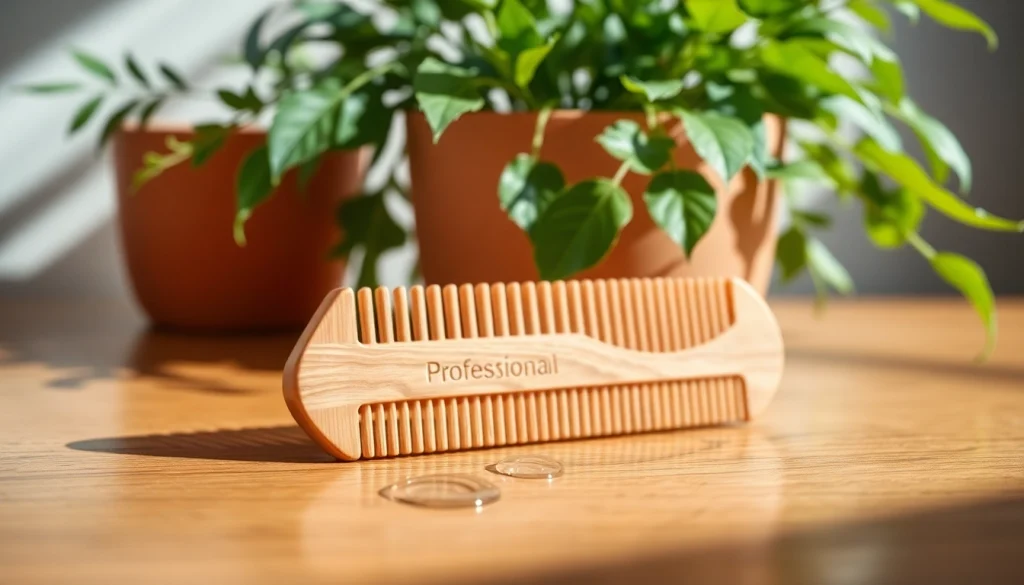Choosing the Right Curly Hair Comb for Healthy, Luscious Locks

Understanding Curly Hair Types
Defining Curl Patterns
Curly hair is beautifully diverse, embodying a variety of textures and shapes. Curl patterns are generally classified into multiple categories based on their formation, ranging from loose waves to tight coils. The most recognized system for defining curl patterns is the Andre Walker classification, which includes:
- Type 1: Straight Hair – Lacks curl and is typically shiny but can be fine or coarse.
- Type 2: Wavy Hair – Forms loose, few spirals and has a soft wave pattern.
- Type 3: Curly Hair – Features defined curls that range from spiral to corkscrew, often thicker than wavy hair.
- Type 4: Coily Hair – Consists of tight curls or kinks, characterized by a Z-pattern shape.
Understanding your unique curl pattern is crucial, as it determines the products to use, the maintenance routine required, and how best to style your curls for optimal definition.
Common Challenges Faced by Curly Hair Owners
Curly hair is both a blessing and a challenge. Many curly hair owners face issues like:
- Tangles: Curls can easily tangle, making them difficult to manage.
- Frizz: High humidity or improper care routines can lead to frizzy hair.
- Dryness: Naturally curly hair tends to be drier due to its structure, as the natural oils have a harder time traveling down the hair shaft.
- Product Buildup: Using too many products can lead to buildup that weighs down curls.
Equipping yourself with the right tools, like a curly hair comb, can make a significant difference in how you manage these challenges.
Characteristics of Healthy Curls
Healthy curls are defined by their elasticity, shine, and ability to hold a style without excessive frizz. Key indicators of healthy curls include:
- Moisture: Well-hydrated curls cut down on frizz and enhance shine.
- Elasticity: Curls that bounce back into shape indicate a healthy strength and moisture balance.
- Minimal Breakage: Healthy hair experiences minimal fallout and split ends.
Taking care to maintain your curl health impacts not just how they look but also their feel and overall manageability.
The Science Behind Combing Curly Hair
Why a Curly Hair Comb is Essential
Using a specialized comb, such as a wide-tooth comb, is vital for maintaining the health of curly hair. These combs are designed to navigate through curls without pulling or damaging the hair shaft. The unique structure of a curly hair comb helps in the following ways:
- Minimizing Breakage: Wide teeth allow for easier detangling, reducing the risk of hair breakage.
- Reducing Frizz: Gentle detangling keeps curls intact, helping prevent frizz.
- Enhancing Definition: Properly combed curls maintain their shape, leading to better definition.
Best Practices for Detangling
Detangling curly hair requires a gentle approach. Follow these best practices to ensure effective detangling:
- Start with Wet Hair: Always detangle when wet and conditioned to maintain curl integrity.
- Use a Mild Conditioner: Using a slip conditioner can ease the detangling process.
- Work from the Tips Up: Start detangling at the ends and work your way up to avoid exacerbating knots.
- Use Your Fingers: You may find finger detangling enhances gentleness before using a comb.
How Combing Affects Curl Formation
The way we comb our curls influences our curl formation and overall hair health. Using a comb strategically can help in:
- Shaping Curls: Using a comb to style can help define curls and enhance their natural shape.
- Creating Volume: Detangling at the roots with a wide-tooth comb can lift curls, adding more volume.
- Pursuing the Right Texture: Depending on the combing technique, curls can appear looser or tightly coiled.
Types of Curly Hair Combs
Wide Tooth Combs: The Go-To Choice
Wide tooth combs are widely recognized as the best option for dealing with curly hair. Their design offers several benefits:
- Spaced Teeth: The spacing between the teeth allows for easy detangling without tugging the hair.
- Less Damage: Reduces the chances of pulling hair out from the roots compared to finer-toothed combs.
- Versatility: Ideal for both wet and dry detangling, making it a multifaceted tool for curl care.
Specialty Combs for Different Curls
Depending on curl types and styles, various specialty combs can benefit specific needs. These include:
- Detangling Combs: Often designed with flexible teeth that can adapt to different textures.
- Pik Combs: Zigzag teeth specialized for creating volume in coily or afro hair.
- Rake Combs: Used for distributing products evenly through curls while styling.
Material Matters: Plastic vs. Wood
Choosing the right material for your curly hair comb can significantly affect the health of your hair. Here are the pros and cons between plastic and wooden combs:
- Plastic Combs: Often more affordable and come in various designs, but may cause static electricity.
- Wooden Combs: Help prevent frizz and static due to their natural properties and have a smoother finish, ideal for fragile curls.
Techniques for Using Your Curly Hair Comb
Detangling Wet vs. Dry Hair
Understanding when to use your curly hair comb is crucial. Here are the best practices for each:
- Wet Hair: Always comb wet hair after conditioning to keep cuticles smooth and reduce breakage.
- Dry Hair: If necessary, use a wide-tooth comb carefully and sparingly to shape curls rather than detangle.
Using Products to Enhance Comb Efficiency
Product choice can greatly enhance the efficiency of your combing routine. Consider these suggestions:
- Leave-In Conditioners: These can provide an added slip for easy detangling.
- Detangling Sprays: Formulated to make the hair more manageable and easier to comb through.
- Oils and Serums: Use sparingly on the ends to enhance shine and moisture retention when combed.
Step-by-Step Comb Techniques for Maximum Care
To maximize the care of your curls while combing, follow these step-by-step techniques:
- Start by wetting your hair and applying a generous amount of conditioner.
- Section your hair into manageable parts to avoid overwhelming tangles.
- Begin using your wide-tooth comb on the ends of each section, working upward towards the roots.
- Use your fingers to separate stubborn knots gently before returning to the comb.
- Once fully detangled, use a product suited to your curl type to finish styling.
Maintaining and Caring for Your Curly Hair Comb
Cleaning the Comb: Tips and Tricks
To keep your comb hygienic and effective, regular cleaning is necessary. Here’s how to do it:
- Regular Rinsing: Rinse combs after each use to remove product residue.
- Deep Cleaning: Soak in warm soapy water weekly to remove dirt and grime; rinse and air dry.
- Disinfection: Use alcohol wipes to sanitize between uses, especially if used on multiple people.
When to Replace Your Comb
The lifespan of a comb can vary, but knowing when to replace it is essential:
- If teeth are broken or bent.
- If it feels rough against your hair.
- When visible buildup of products cannot be cleaned off.
Combing Myths: What to Ignore
Many myths surround curly hair care; debunking these can help you navigate the best practices:
- Myth 1: Combing dry curly hair is okay — This can lead to excessive frizz and breakage.
- Myth 2: Any comb will do — Specialized combs are designed to maintain curl health.
- Myth 3: You should wash your hair daily — Over-washing can strip natural oils and lead to dryness.






